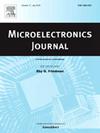具有 25 Vpp 的自动归零斩波稳定电容耦合仪表放大器
IF 1.9
3区 工程技术
Q3 ENGINEERING, ELECTRICAL & ELECTRONIC
引用次数: 0
摘要
本文提出了一种具有超越电源轨共模干扰(CMI)消除(CMIC)能力的心电图(ECG)信号放大器。该放大器由比较器逻辑、电流源电荷泵(CSCP)、输入预充电缓冲器和自动归零(AZ)电容耦合斩波仪表放大器(CCIA)组成。文章将分析 CMI 抑制电路的原理和电路细节。该电路基于标准 180 nm CMOS 工艺,可在 1.8 V 电源下实现 25 Vpp 的电源线 CMI 容差。输入 CMI 为 4 Vpp 时,功耗为 151.91 μW,总谐波失真 (THD) 为 -78.8 dB,有效位数 (ENOB) 为 12.02 位。 本文章由计算机程序翻译,如有差异,请以英文原文为准。
An auto-zeroing chopper-stabilized capacitively coupled instrumentation amplifier with 25-Vpp common-mode interference tolerance
In this paper, an Electrocardiogram (ECG) signal amplifier with beyond supply rail common-mode interference (CMI) cancellation (CMIC) capability is proposed. The amplifier is composed of a comparator logic, a current source charge pump (CSCP), input pre-charge buffers, and an auto-zeroing (AZ) capacitively coupled chopper instrumentation amplifier (CCIA). The principle and circuit details of the CMI suppression circuit will be analyzed in the article. Based on a standard 180 nm CMOS process, it achieves a 25 power line CMI tolerance from a 1.8-V supply. At an input CMI of 4 , it consumes 151.91 W, achieves a total harmonic distortion (THD) of -78.8 dB, and has an effective number of bits (ENOB) of 12.02 bits.
摘要
本文提出了一种具有超越电源轨共模干扰(CMI)消除(CMIC)能力的心电图(ECG)信号放大器。该放大器由比较器逻辑、电流源电荷泵(CSCP)、输入预充电缓冲器和自动归零(AZ)电容耦合斩波仪表放大器(CCIA)组成。文章将分析 CMI 抑制电路的原理和电路细节。该电路基于标准 180 nm CMOS 工艺,可在 1.8 V 电源下实现 25 Vpp 的电源线 CMI 容差。输入 CMI 为 4 Vpp 时,功耗为 151.91 μW,总谐波失真 (THD) 为 -78.8 dB,有效位数 (ENOB) 为 12.02 位。本文章由计算机程序翻译,如有差异,请以英文原文为准。
An auto-zeroing chopper-stabilized capacitively coupled instrumentation amplifier with 25-Vpp common-mode interference tolerance
In this paper, an Electrocardiogram (ECG) signal amplifier with beyond supply rail common-mode interference (CMI) cancellation (CMIC) capability is proposed. The amplifier is composed of a comparator logic, a current source charge pump (CSCP), input pre-charge buffers, and an auto-zeroing (AZ) capacitively coupled chopper instrumentation amplifier (CCIA). The principle and circuit details of the CMI suppression circuit will be analyzed in the article. Based on a standard 180 nm CMOS process, it achieves a 25 power line CMI tolerance from a 1.8-V supply. At an input CMI of 4 , it consumes 151.91 W, achieves a total harmonic distortion (THD) of -78.8 dB, and has an effective number of bits (ENOB) of 12.02 bits.
求助全文
通过发布文献求助,成功后即可免费获取论文全文。
去求助
来源期刊

Microelectronics Journal
工程技术-工程:电子与电气
CiteScore
4.00
自引率
27.30%
发文量
222
审稿时长
43 days
期刊介绍:
Published since 1969, the Microelectronics Journal is an international forum for the dissemination of research and applications of microelectronic systems, circuits, and emerging technologies. Papers published in the Microelectronics Journal have undergone peer review to ensure originality, relevance, and timeliness. The journal thus provides a worldwide, regular, and comprehensive update on microelectronic circuits and systems.
The Microelectronics Journal invites papers describing significant research and applications in all of the areas listed below. Comprehensive review/survey papers covering recent developments will also be considered. The Microelectronics Journal covers circuits and systems. This topic includes but is not limited to: Analog, digital, mixed, and RF circuits and related design methodologies; Logic, architectural, and system level synthesis; Testing, design for testability, built-in self-test; Area, power, and thermal analysis and design; Mixed-domain simulation and design; Embedded systems; Non-von Neumann computing and related technologies and circuits; Design and test of high complexity systems integration; SoC, NoC, SIP, and NIP design and test; 3-D integration design and analysis; Emerging device technologies and circuits, such as FinFETs, SETs, spintronics, SFQ, MTJ, etc.
Application aspects such as signal and image processing including circuits for cryptography, sensors, and actuators including sensor networks, reliability and quality issues, and economic models are also welcome.
 求助内容:
求助内容: 应助结果提醒方式:
应助结果提醒方式:


